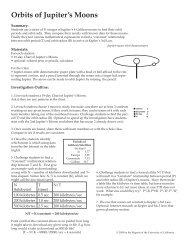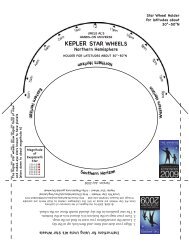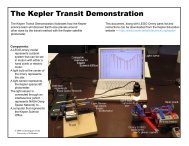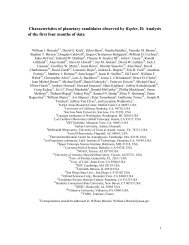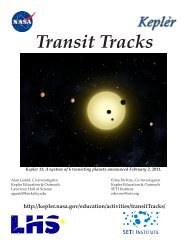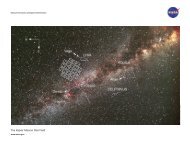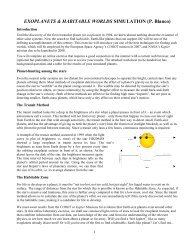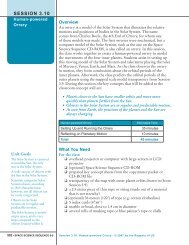Poster Abstracts - Kepler - NASA
Poster Abstracts - Kepler - NASA
Poster Abstracts - Kepler - NASA
- No tags were found...
Create successful ePaper yourself
Turn your PDF publications into a flip-book with our unique Google optimized e-Paper software.
POSTER ABSTRACTSP0505. POSTER SESSION IThe Effect of Exotic Clouds on the Transmission Spectra of Transiting Super-Earths.C. V. Morley 1 , J. J. Fortney 2 , M. S. Marley 3 , C. Visscher 4 .1UC Santa Cruz, 1156 High St, Santa Cruz, CA (cmorley@ucolick.org), 2 UC Santa Cruz (jfortney@ucolick.org),<strong>NASA</strong> Ames Research Center (mark.s.marley@nasa.gov), 4Southwest Research Institute, Boulder(visscher@boulder.swri.edu).The formation of clouds in exoplanetatmospheres is expected to significantlychange the observable spectra. This is widelyunderstood for solar system planets andbrown dwarfs. For exoplanets, the gray opacityof hazes or clouds has been invoked as apossible explanation for the observed flattransmission spectrum of transiting super-Earth GJ 1214b [1]. Previous atmospheremodels for irradiated planets have includedthe most important condensates expected toform in brown dwarf and giant planet atmospheres— iron, silicate, and corundum — buthave not included the condensates expected toform at colder temperatures.The most important of these newclouds are sodium sulfide, potassium chloride,and zinc sulfide. These clouds should bemost prominent at low surface gravity,strongly super-solar atmospheric abundances,and at the slant viewing geometry appropriatefor transits. Hence they could be quite importantfor affecting the transmission spectra ofcool low density super-Earth and Neptuneclassplanets.Here, we present results from a seriesof 1D atmospheric models that include thesepreviously ignored condensates for the transitingsuper-Earths GJ 1214b and HD 97658b[2]. We vary both the metallicity of the atmosphereand the thickness of the cloudlayer, and we determine whether these exoticclouds could be sufficiently optically thick toreproduce observations of GJ 1214b.Pressure-Temperature Profiles withCondensation Curves:Pressure-Temperature profiles of transitingSuper-Earths GJ 1214b and HD 97658b areplotted with the condensation curves of allclouds expected to form. Cloud bases arelocated at the intersection between profiles andcondensation curves. Note that the pressuretemperature profiles cross the sodium sulfide,zinc sulfide, and potassium chloridecondensation curves; these clouds will form inthe upper atmosphere of both planets.[1] Bean et al. (2011) submitted to ApJ.[2] Henry et al. (2011) submitted to ApJ.1702011 <strong>Kepler</strong> Science Conference - <strong>NASA</strong> Ames Research Center



